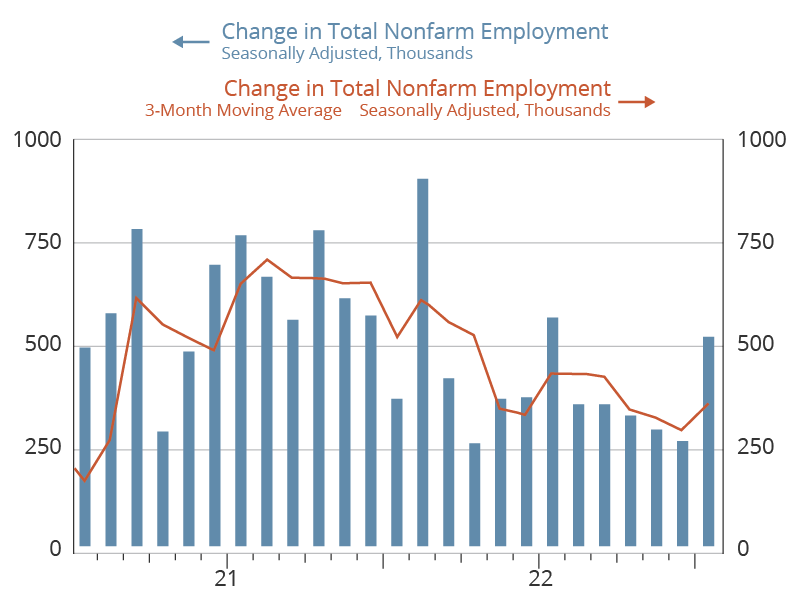As the workplace continues to rebuild itself in a post-COVID world, a major set of outstanding questions concerns the type of jobs that will be in demand, as well as the forms of work most beneficial to the broader economy. The most recent employment report showed 517,000 jobs added in January, a number far beyond the 190,000 that had been projected. In addition, the length of the average workweek increased by nearly a full half-hour, and the wage level rose by 0.3%. Employers are hiring while asking more from their existing workforce – and are willing to pay for it.
517,000 Jobs Added to U.S. Economy in January

These seem like healthy signs to start 2023. However, optimism here must be balanced with issues constricting the supply of workers (a future Kenan Insight will address this topic), increases in the cost of living, and very real recessionary concerns. Should a recession occur, which sectors will be hit the hardest? Despite the woes of the tech sector, employment for tech skills continues to grow, albeit at a slower pace. This is due to the large role these skills play in the modern economy. Other areas, however, might not be quite so lucky.
While we cannot predict the fate of specific industries, we do know that we will continue to see the emergence and development of new technologies, new problems and new consumer preferences. As such, demand for specific skills will remain in flux. Below, we take a closer look at these and other issues that will serve as the primary labor demand themes we’ll focus on in our grand challenge.
Technology
Increased use of technology and automation has brought productivity gains, benefiting the economy overall. As the speed of technological advancements continues to increase, however, one of the limitations to adopting productivity-increasing automation is the lack of trained employees to install, operate and manage these technologies. This issue of a “skills gap” between the needs of employers and the abilities of the workforce is not new, but the speed of technological development has magnified this mismatch. Existing approaches to training cannot keep up with changing firm-level demands. How do we create a workforce that possesses the skills employers need when those needs are changing rapidly?
It is always hard to predict the future, especially to anticipate new technologies that will change how we do work. However, we can use past technological advances as a guide. Since the 1980s, when the price of computing power started becoming more affordable for companies to adopt, we have seen profound changes in the labor market. Between 1980 and 2010, we saw large declines in agricultural, blue-collar and clerical workers relative to other occupations, such as managers, professional occupations and service occupations.
In addition, we’ve seen sharp advancements in the type of human work that can now be automated. To date, computers have been most proficient at following preplanned routines. Not surprisingly, we have seen technology disproportionately replace employees engaged in routine tasks (for example, banks needed fewer tellers after they adopted ATMs). At the same time, technology tends to make existing employees more productive; writing this insight on a computer certainly saves time as opposed to using a typewriter.
To date, the net effect of technology on employment has not led to fewer jobs overall, but instead shifted the demand by firms from some occupations (such as data entry clerks) to new occupations (such as computer programming). According to the Bureau of Labor Statistics, the jobs with the highest projected percentage growth over the next decade will include nurse practitioners, wind turbine service technicians and data scientists. Most of these professions have a heavy interaction with new technologies or require human-to-human interaction.
But how will this change? Will artificial intelligence and ChatGPT fundamentally change the dynamic? History suggests otherwise, but perhaps this time is different. The one thing we do clearly know is that the skills demanded by employers will constantly evolve. Workers will need additional training throughout their careers to respond to changing skill needs by employers. But how will workers get this training? How do we build a sustainable economy with constant retraining?
NCGrowth, an affiliated center of the Kenan Institute, provides two successful examples through its economic development case study site, HomeGrown Tools, where communities have successfully stimulated private investment and job creation. The town of Rugby, North Dakota, partnered with a statewide training program to enhance the job skills of residents when its workforce lacked computer skills. Another illustrative case took place in Morrilton, Arkansas, where a coalition of community leaders developed partnerships and job training programs for workers put out of work when two large employers closed their doors in the same week.
These and other case studies demonstrate that local governments can play a major role in bridging gaps between the demand and supply sides of the labor market. When a mismatch exists between the set of available jobs and the capabilities of a given workforce, the public and private sectors can and should work together to find creative retraining solutions.
Reshoring
Deglobalization is likely to amplify the skills gap associated with technology as well as alter labor demand in other ways. International supply chains became a liability over the last few years given the COVID-19 pandemic, as well as associated lockdowns and border closings. In response, U.S. firms are moving more manufacturing back home; a recent report from the Reshoring Initiative estimated that 350,000 jobs were brought back to the U.S. in 2022.1 While these jobs are certainly welcome, the return of manufacturing will require significant investment in plants, property and equipment to build more goods domestically. More important, it will also require an adequate supply of workers.
The semiconductor industry is one example of this trend. Fueled in part by the passage of the CHIPS and Science Act of 2022, a number of firms have announced the construction of new manufacturing facilities in the U.S. Micron Technology is adding facilities in Boise, Idaho, and, more recently, Clay, New York. Intel recently broke ground on a facility in Ohio, as did TSMC in Phoenix and SkyWater in West Lafayette, Indiana. If all new chip manufacturing capacity is built as planned, it will require an estimated 30,000 new high-tech employees, which will only exacerbate the skills gap.
Moreover, reshoring will add demand for jobs outside the high-tech industry. For example, before all these new high-tech workers can don their “bunny suits” to manufacture microchips, we first need an army of construction workers to build these factories. Those additional new jobs will spur more economic development in the surrounding microeconomies – a phenomenon we examine in our American Growth Project.
New Leaders
Finally, while there is a focus on demand for hard skills, such as AI, skilled manufacturing and data scientists, there has also been a shift in the types of managers that firms need. Leaders in 2023 must be able to manage a demographically diverse workforce that may also be geographically diverse, with some employees working from home. As employee preferences change, managers must also be able to adapt and meet these evolving needs while also staying on top of ever-evolving technology. This becomes particularly important considering the pace of technological change mentioned above; so-called soft skills such as communication and facilitating social interaction remain a domain in which humans vastly outperform machines.2
Stay Tuned for More
While the year is starting off with some strong signs from the demand side of the labor market, the current uncertainty around economic conditions leaves us with numerous questions as to how the coming year will play out. In the long term, workers and firms are in the midst of finding a new equilibrium for the modern labor market – one in which demand for a skilled and agile workforce is meeting changes in what individuals want out of their work lives. We will discuss both dynamics over the next year, combining academic expertise with an ear to the ground through our Kenan Insights, commentaries, webinars and conferences. We look forward to you joining us in this exploration.
1 Reshoring Sets New Record in Q3 2022. (2022, December 22). Material Handling & Logistics. https://www.mhlnews.com/global-supply-chain/article/21256833/reshoring-sets-new-record-in-q3-2022
2 Deming, D. J. (2017). The Growing Importance of Social Skills In The Labor Market. The Quarterly Journal of Economics, 132(4), 1593–1640. https://www.jstor.org/stable/26372714
